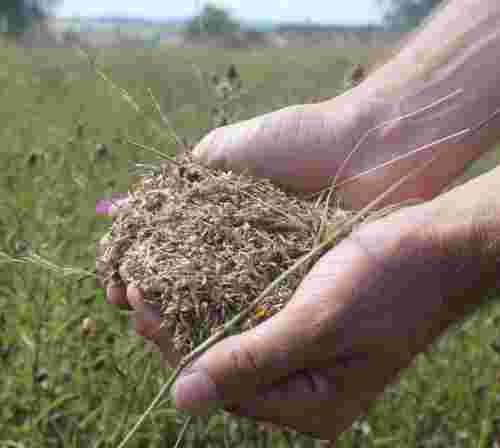Monday 7 November 2022 at Bath Royal Literary and Scientific Institution, Queen Square, Bath
Dan Merrett, Manager of Bathscape, was first involved in creating grassland when he was employed on the Coronation Meadows project organised by Plantlife and other environmental organisations. It ran from 2013 to 2017 and involved the creation of new species-rich meadows across 60 English counties to celebrate Queen Elizabeth’s diamond jubilee. 90 meadows were created, the last launched to coincide with the Queen’s 90th birthday. Bathscape aims to improve Bath’s natural surroundings by encouraging and helping landowners to increase biodiversity through changes in land management.
Traditionally the term ‘meadow’ was used to describe grassland mown for hay but nowadays it is used to describe any grassland that is allowed to grow tall enough to flower, whether it is cut for hay, grazed or is managed in any other way.
Between the 1930s and the mid-1980s lowland England and Wales lost an estimated 97% of their semi-natural grassland. Since the 1940s an increased focus on yields has driven government advice and policy. In the 20th century there was a shift towards the use of inorganic fertilizers to add nitrogen, phosphorus and potassium and promote ever richer grass growth.
Where possible, traditional meadows were ploughed and replaced by ‘grass leys’: Land sown with commercial grass seed, often just one species such as Perennial Ryegrass, which is cut for silage. These have very low species diversity and are far less effective at carbon capture than a traditional meadow. Ever bigger farm machinery compacts the soil. Species rich grassland attracts many more invertebrate species, including those important as pollinators, and these in turn provide food for birds and bats.
It takes an afternoon to destroy a good meadow but several years to create one. Surviving traditional meadows, such as those at Clattinger Farm, are highly valued because the farming practices that result in such grassland are now rarely used. In traditional low-input systems, soil fertility is automatically improved by the manure produced by stock when they are introduced after mowing. Surviving meadows reflect the natural flora of the area, the conditions of the site and also the history of its management. There is concern that the creation of new meadows can ignore this local distinctiveness and genetic individuality and can introduce species and subspecies that are not suited. For the Coronation Meadows project, meadows from which seed was obtained were always selected from nearby donor meadows.
To prepare a field, cutting the sward very short or introducing a period of heavy grazing helps. Then harrowing, raking other techniques can be used to break up the turf so that bare soil is available for seed to germinate. For Coronation Meadows where the farmer was concerned about possible reductions in yield, alternating strips were left untouched.
A cost-efficient method of improving diversity is to take a hay cut from the donor meadow on a dry day in late July or August then spread the hay across the prepared field.

Seeds ready for sowing.
This works well only if the donor field is fairly close (up to 15 miles away) because green hay quickly heats up in transport and will affect the viability of the seed. The disadvantage of this method is that you only collect what seed is ripe on the day you cut. Alternatively special equipment is available that can be towed across a field, knocking off seed heads and other material into a hopper as it goes. It can then either be transferred and used straight away or sieved, dried and stored for later use.
To germinate, seed needs to be in contact with the soil. If green hay is used, stock can be introduced for a short period and will trample the seed into the soil. In the absence of stock, this will need to be a manual exercise. If seed is used then it can be rolled in. More novel ideas have been tried such as arranging a football match.
In the first spring it is useful to keep the sward open, allowing more seed to germinate. An early cut will achieve this, but is not advisable where Yellow Rattle has germinated as it is an annual. Pernicious weeds like dock and creeping thistle should be removed before they get the chance to go to seed. This is best done by hand. Once established, a wild flower meadow requires management, either in the traditional way by cutting hay and/or grazing, or by other means that mimic these activities. Local examples that appear to have been successful are two wild flower areas which have been established at Innox Park, Twerton.
On a garden scale you are most likely to use a commercial seed mix. The first thing to check is whether you are buying seed of annuals or perennials. Annuals are suitable for flower beds but perennials are required to produce an artificial meadow. Secondly check that seed has come from the UK and whether it is suitable for your soil type. Also check it is not out-of-date. Some seed remains viable for just a short time, especially Yellow Rattle. For species which are difficult to establish, the planting of plugs is more effective.
Rewilding in the sense of leaving nature to take its course will not, in the long term, produce a species-rich area unless there are grazing animals to stop the most dominant species taking over.
The Carr’s Wood grassland on the edge of Twerton is a good example. Before Twerton expanded to the point when these fields were no longer viable as farmland, the slopes were rich in wild flowers. Without grazing the first things to appear were brambles, shrubs and tree seedlings, along with large patches of perennial weeds. The tougher grasses form a ‘thatch’ at ground level, which enriches the soil and stops other species from germinating. Eventually the shade caused by the woody species result in an area of woodland, but with very few woodland flowers beneath.

Recent Comments